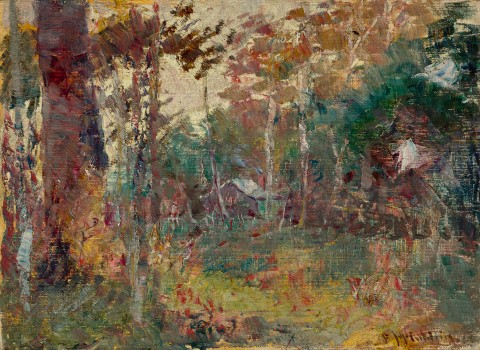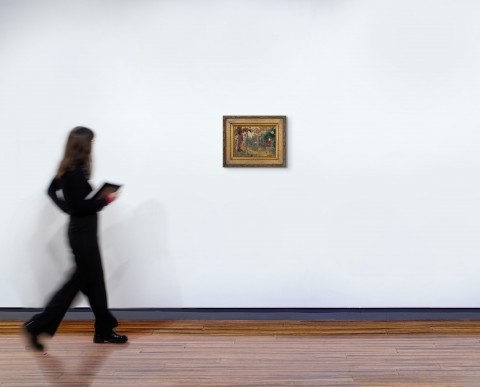EDGE OF THE CLEARING
FREDERICK MCCUBBIN
oil on canvas on cardboard
25.5 x 35.0 cm
signed lower right: F. McCubbin
bears inscription on frame verso: Edge of the Clearing F McCubbin
Private collection
Artarmon Gallery, Sydney, September 1965 (label attached verso)
Sir Leon and Lady Trout, Brisbane
The Collection of Sir Leon and Lady Trout, Christies, Brisbane, 6 June 1989, lot 170
Henry Krongold, Melbourne
The Estate of Paul Krongold, Melbourne
Master Works from the Collection of Sir Leon and Lady Trout, Queensland Art Gallery, Brisbane, 21 September – 14 December 1977, cat. 24 (label attached verso)
It is highly plausible that Edge of the Clearing is one of the studies done by Frederick McCubbin in preparation for his masterpiece The Pioneer, 1904 (National Gallery of Victoria). This monumental triptych has mesmerised audiences since its first display, a poignant tale of a pioneering family and the property they establish in the bush. At the rear of the central panel is the settlers’ cottage which bears a marked similarity to the one seen here, framed by large trees and partially obscured by saplings. The technique and setting also identifies Edge of the Clearing as being painted before 1907, when McCubbin went to Europe, radically changing his style on return. It further bears a marked similarity to the bush around the artist’s family home ‘Fontainebleau’ at Mt Macedon, north of Melbourne.
McCubbin and his wife Annie purchased this property in 1901 and, as his youngest daughter Kathleen recalled, her father’s ‘greatest love was the bushland at Mt Macedon. The mystique of the Australian bushland intrigued him: the sunlight glinting through the tall timbers, the secret colours in the abundant undergrowth, the call of the birds, and the whispering breeze… He loved them all.’1 It was a bush landscape populated by stringybarks, bracken, wattle and manna gums, and Edge of the Clearing accurately coveys the scrubbiness and dappled light which so intrigued the artist. However, the cottage itself was more likely to be one from the adjoining property, ‘Ard Choille’ (meaning ‘height of the woods’ in Scots Gaelic), owned by William McGregor who built a number of little cottages there, with the one shown in The Pioneer having been used by the keeper of his bull farm.2 McCubbin painted a great number of important and wonderfully atmospheric paintings around Fontainebleau, indicative of his belief that ‘(n)ature under our Australian sky seems to me like a shy, reserved person, ready to repel you; but you only have to wait and watch her varying moods, and you will find all the beauty you want.’3 Unfortunately the scene is now radically changed. Sold during the Depression, the property was subsequently logged for milling before bushfires cleared the rest until it became a grassed paddock for horses.4 Ironically, recent years of neglect have seen much of Fontainebleau’s bushland return.
When The Pioneer was exhibited, the critic for The Age noted that ‘one condition of success, apart from the question of the necessary technique, is that the artist remains true to the spirit of our landscape, and to the spirit in which we live our lives amid it, as Mr McCubbin has done.’5 Though far more modest in scale, this observation rings true for Edge of the Clearing as well, and apart from its quality, as implied through its subsequent ownership by the Trout and Krongold families, the painting bears a further distinctive feature, its original frame. This is almost certainly made by master frame-maker John Thallon, and ‘uses composition ornaments on a wooden chassis. The torus ornament is conventional imbricated laurel leaves and berries, cross-banded at the corners. The flat is sanded.’6 A very similar example can be found on John Ford Paterson’s Fernshaw, 1896 (Castlemaine Art Museum).
1. Mangan, K., Daisy Chains, War, the Jazz, Hutchison, Melbourne, 1984, p. 70
2. ibid., p. 126
3. Frederick McCubbin. Quoted in: ‘Amongst the country studios’, The Age, Melbourne, 10 February 1894, p. 14
4.See: McKenzie, A., Frederick McCubbin 1855-1917: ‘The Proff’ and his art, Mannagum Press, Melbourne, 1990, p. 129
5. The Age, Melbourne, 16 August 1905, p. 6
6. Payne, J., Framing the Nineteenth Century: Picture Frames 1837- 1935, Peleus Press/National Gallery of Victoria, 2007, p. 174
ANDREW GAYNOR


